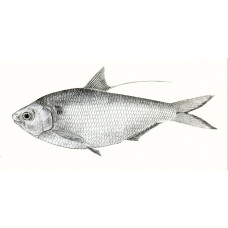Latin name
Nematalosa nasus
Other names
Gizzard shad, hairback, long-finned gizzard shad, long-ray bony bream, thread-finned gizzard shad.
Identification
Body rather deep, its depth about 34-41% of the standard length, abdomen with 17-20 + 9-13 scutes, total 28-32 scutes; anterior part of preoperculum with third infraorbital bone just above it, without fleshy gap between them; mouth inferior, mandible strongly extended outwards; last dorsal fin filiform; pectoral axillary scales present; posterior margin of scales distinctly toothed.
Features of fish fins
Dorsal spines (total): 0; Dorsal soft rays (total): 15-19; Anal spines: 0; Anal soft rays: 21-25.
Fish colouring
This fish can be distinguished from other species by the presence of a dark spot behind the gill opening.
Distribution
Widespread in the western Pacific, east of the Andaman Sea, South China Sea and the Philippines to the Korean Peninsula. The only specimen has been found in South African waters.
Habitat
Marine tropical freshwater and brackish pelagic-neritic fish. Depth range from 0 to 30 meters.
Size
The largest known standard length of this species is 22 cm. Maximum length: 27.2 cm.
Behavior
Passage fish. Inhabits estuaries and coastal areas, sometimes ascending to the upper intertidal zone.
Food and feeding habits
It feeds on plankton.
Reproduction
Females lay eggs in batches. Eggs are transparent, pale pink or amber, semi-fluid and non-sticky.
Fishing
Has little commercial significance.
Relationship with a person
A common food fish. Very bony.
| Classification | |
| Phylum | Chordata |
| Class | Actinopterygii |
| Squad | Clupeiformes |
| Family | Dorosomatidae |
| Genus | Nematalosa |
| Species | N. nasus |
| Features | |
| Conservation status | Least Concern |
| Habitat | Pelagic |
| Life span, years | No information |
| Maximum body weight, kg | No information |
| Maximum length, cm | 27,2 |
| Sailing speed, m/s | No information |
| Threat to people | Edible |
| Way of eating | Planktonophage |
Bloch's gizzard shad
Tags: blochs gizzard shad

